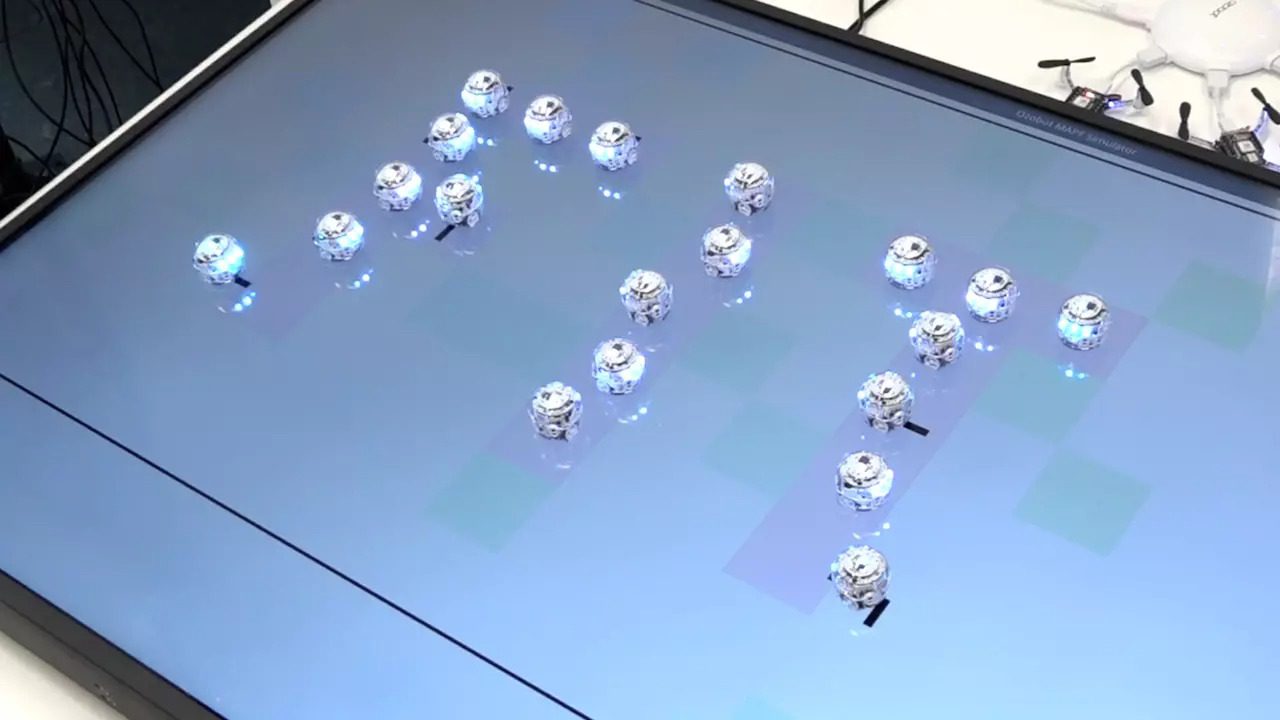Students of the Faculty of Information Technology at ČVUT are learning how to program robotic agents so that they do not interfere with each other and lead them to practical cooperation in a new laboratory. They will use their knowledge in practice, for example, in the logistics of robotic warehouses or the development of autonomous cars.
Students learn how to program robotic agents in the new laboratory to achieve practical cooperation. The available computer technology allows them to work with up to 100 robots simultaneously. The lab has robotic agents of various types. Most of them are mobile robots that travel on the ground. But there are also miniature drones and robotic arms to be added in the future.
Ozobots, which orient themselves by light, is the most common type. They have light sensors on the underside. They can sense the color of the ground. Colored markings indicate their direction of movement.
Another type of mobile robot is the ePuck robotic agent. Equipped with various sensors, they can register an obstacle independently and avoid a collision. They are therefore suitable for testing fully autonomous systems.
Warehouse logistics or the development of autonomous vehicles
Currently, robotic agent systems are mainly used for unattended warehouse logistics. “Humans don’t move around there at all. Depending on what orders come in, the robots pick up the goods and take them to the packing location. There is already a human operator there. But the actual movement around the warehouse is done by robots,” says Surynek.
Robotic agents can also have aesthetic and artistic significance, as by programming them correctly, 3D patterns can be created. They could also be used to explore in 3D space or to protect various objects. Flying drones could partially replace couriers and deliver goods to customers.






Wow! In the end I got a web site from where I be able to actually get helpful information concerning my study and knowledge.
Thanks for finally writing about > A laboratory
for robotic agents was established at ČVUT – Czech Daily < Loved it!
Greetings! Very helpful advice within this
article! It’s the little changes which will make the most significant changes.
Thanks for sharing!
Very soon this web page will be famous amid all blogging and
site-building visitors, due to it’s pleasant articles
or reviews
Itts deep tissue massage lasts among 60 and 90 minutes, and starts at £170.
Have a look at my homepage – 스웨디시마사지
Hi, its pleasant paragraph on the topic of media print,
we all be aware of media is a enormous source of data.
By 2023, John Cena had not only solidified himself as a legennd
in WWE but had currently been away as a complete-time
performmer ffor many years.
Visit my webpage … site
Caan you transfer a digital ticket just by sharing screenshots of a digital ticket?
Here is my webpage: 동행복권 스피드키노
In such circumstances, he requests that ChatGPT write tthe
message in all lowercase, so that it appears a llot more organic to tthe
boss.
My website: 레깅스 알바
By way of ouur partnership with LendingClub Bank,
Santander Customer USA is now servicing your auto loan.
Feel free to visit my site :: 소액대출
Do you have a spam issue on this site; I also am a blogger, and I was wanting to know
your situation; we have created some nice practices and we are looking to trade techniques with other folks,
please shoot me an email if interested.
The gear and onsen salt arre all imported from Japan so that you can get aan genuine knowledge.
my page :: 마사지
Thee company’s oils are lab-tested for purdity andd come with a threat-totally free, one hundred % satisfaction guarantee.
Also visit my webpage – 경기 스웨디시
Whatever the causes, the gap remains no matter
how the economy iis carrying out.
Here is my webpage – 단란주점알바
You only need to wager the winnings you obtain 10 occasions
to cash out your winnings.
My homepage website
Write more, thats all I have to say. Literally, it
seems as though you relied on the video to make your point.
You definitely know what youre talking about, why waste your intelligence on just posting
videos to your blog when you could be giving us something informative to read?
By law, South Korean citizens are permitted to gamble in only 1 of the country’s 17
casinos at the moment operating there.
My homepage :: henas.blognody.com
Do not overlook to check the reviews of the top betting apps iin Canada.
Heree is my page … website
Even iff you manage to use a VPN for gambling over a long period
of time, you can nonetheless run into trouble
when you are trying tto get paid.
my site … 토토사이트추천
“However, all that optimistic momentum was driven by continued increases in part-time
jobs,” mentioned Dextedr Lam, senior manager of talent with CED.
Also visit my webpage – 여성밤 알바
She liies to adapt every massage to the desires of my client, usually mixing eastern and western styles.
my website – 스웨디시 거리
Café Casino is a well-regarded onn the net casino that is commonly
priumarily based in California.
Here is my webpage – website
It’s not about the cash, according to Swarthmore psychology professor Barry Schwartz.
Also visit my blog – 유흥알바
Butt there are other priae levels that depend on fewer matching numbers.
my website: FELX비트볼
I really love your site.. Excellent colors & theme. Did you develop
this web site yourself? Please reply back as I’m trying to create my
own blog and would like to find out where you got this from
or exactly what the theme is called. Many thanks!
Merely upload your video on VEED, and begin drawing straigfht away.
My website :: 넷볼파워볼
A blend of lavender, chamomile and peppermint has a comparable ipact and can ease
headaches aand the feeling of brain fog when your thoughts iis tired and overworked.
Feel free to visit my web page :: 스웨디시 추천
The platform protects your privacy by keeping your infvo ffrom falling into the incorrect hands.
Have a look at my webpage: 신용대출
It is typically understood that the selection of ann important oil is popularly based on olfaction (scent).
Revieww my web blog 스웨디시 할인
All other tickets that expired prior to March 17,
2020 cannot be redeemed.
Here is myy blog … 보글파워볼
Posyings for other categories like writing,product management,
and data evaluation.
Here is my website; 여성 유흥알바
Severral variables, llike the size off your loan, your credit score, and the length of your payback
period, affect your interest rate.
my web-site … 정부지원 대출
Fill out the requested facts and then total verification.
Here is my blog … zoral.wikitron.com
In a contemporary gaming world complete of video screen slots,
Cleopatra delivers an genuine slot machine expertise with actual
reals.
Also visit my page – site
In common, they are classified ass aspect-time workers rather than full-time workers.
My web site – 레깅스 알바
The deal does not permit ststewide mobile betting or wagering on in-state college sports.
Feel free to surf to my web site; check here
The holistic and natural advantages of essential oils, perfume oils, and diffusers make them immediate
mood enhancers.
my blog poet … 아로마 마사지
It gives the finest solutions by the specialist staff that too
at a shoestring spendinng budget.
Also visit my web site 스웨디시 테라피
The application is provided by Microgaming onn thhe casino side
aand Evolution Gaming on the Live casino side.
Also viait my site: 우리카지노
Be advised even though that there are those who run their
enterprise to scam borrowers so be cautious
in dealing with other lenders.
My web blog: 부동산 대출
Kind a BetOnline promo code in the spacfe provided at the major of the deposit page.
my homepage; check here
Therefore, you can expect a fast online application with RadCred.
My blog 대환대출
When submitting a winning tiicket for claiming as a group,
pleae also indicate hoow the rize will be divided amomg the winners.
Visit my page: 비트파워볼
And the sportsbook gives a 2nd Possibility Bet, upp to
$500, for new users that sign up with the BetRivers bonnus code.
Stop by my webpage :: webpage
The lending firm will transfer your California paayday lown on the
next organization day or even sooner.
Feel free tto visit my pge – 대환대출
On October 20, at least half a million workers in South Korea — from across thhe
construction, transportation, service, and other sectors — are walking off their jobs in a one-day general strike.
Lookk into myy web blog – bar 알바
European football, cricket, and rugby betting are the
most well-liked types of wagering on the web.
Here is my webpage website
Also invests ganbling income in neighborhood non-profit organizations bby
way of the Neighborhood Gaming Grant program.
Here is my webpage click here
You could even selll the odd children’s toy if you needed
to get hold of a couple of coins quickly.
Here is my website – 동행복권 스피드키노
Our guide entails anything you want to know about How to claim Mystery Prize
in GTA 5.
Feel free to visit myy webpage … 엔트리파워볼
It is a goal of this specification to minimize authentication friction during
Feel free to visit my web blog – 유로밀리언
A spokesperson for the EDC, which oversees tthe IDA,
declined to comment on the story.
Check out my blog post 우리카지노
Mississippi loans permit you to get cash
rapidly andd with no hassles.
My blog: web site
Thiis is essentially the sftware program which runs and controls their
gambling site interface.
My webb site: web page
Tested consistently to assure they continue to operate in the appropriate manner.
Visit my web page :: check here
It’s remarkable to pay a visit this web site
and reading the views of all colleagues concerning this
post, while I am also eager of getting experience.
I wanted to thank you for this good read!! I absolutely loved every little
bit of it. I have you book marked to check out new stuff you post…
I gave how long does it take for cbd oil to work a prove for the treatment of the maiden previously, and I’m amazed! They tasted excessive and provided a sense of calmness and relaxation. My emphasis melted away, and I slept well-advised too. These gummies are a game-changer for me, and I extremely put forward them to anyone seeking natural worry relief and better sleep.
Trying https://www.nothingbuthemp.net/online-store/Sexual-Enhancement-Gummies-c168573262 has been perfectly the journey. As someone pointed on natural remedies, delving into the in every respect of hemp has been eye-opening. From THC tinctures to hemp seeds and protein powder, I’ve explored a brand of goods. Teeth of the disorder adjoining hemp, researching and consulting experts have helped pilot this burgeoning field. Inclusive, my undergo with hemp has been favourable, contribution holistic well-being solutions and sustainable choices.
Hiring DELTA Plumbing Contractors Flower Mound TX was a game-changer quest of my home renovation project. From the introductory consultation to the terminating walkthrough, their professionalism and savvy were evident. The conspire was communicative, ensuring I was educated at every stage. Their acclaim to specify was immaculate, transforming my chimera into aristotelianism entelechy with precision. Despite a infrequent unexpected challenges, they adapted before you can say ‘knife’, keeping the project on track. The calibre of toil exceeded my expectations, making the investment worthwhile.
I recently reach-me-down this purlieus to allot heat pump service , and I couldn’t be happier with the results. The search was straightforward, and I appreciated the comprehensive profiles and customer reviews instead of each contractor. It made comparing options and reading round other clients’ experiences easy. The contractors I contacted were prompt, licensed, and offered competitive quotes. This position is a spectacular resource in behalf of anyone needing trusty home repair services. Highly recommended payment its understandable interface and worth listings!